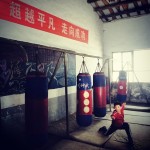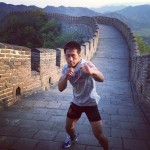The other day I wrote a story for Fightland about an interaction I had had with Chen Jia, the Taiji Princess I’ve mentioned here before. It was about a fight her master’s brother, Chen Ziqiang, was setting up with Thai fighters. I spent an hour telling her how bad the idea was.
I reenacted that for the Fightland story, and then went on to hijack Prof. Ben Judkin’s essay on taiji and Taoism as symbols in a marriage of convenience, to link the idea of Chinese patriotism to Taoism/Taiji and through that find some explanation for what I considered to be an absurd, misguided macho ploy. I ended the story by saying I was happy the fights did not take place, because I didn’t want to see taiji sullied.
But in fact, the fight did go down. Last September in Jiaozuo, Henan Province, just a few hours from Chenjiagou Village and the Shaolin Temple.





